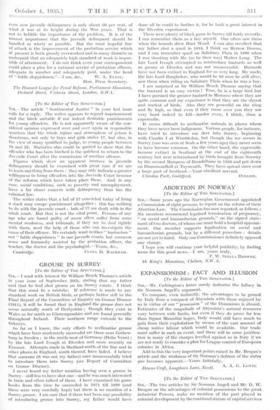GROUSE IN SURREY.
[To the Editor of TIIE SPECTATOR.] Sin;--bread with interest Sir Winkler. Beach Thomas's article in your issue of September 20th, stating that my father said that he had shot grouse on his Surrey estate. I think that this must be a 111;s-fake. If reference is made to any standard work on British birds, or perhaps better still to the Final Report of the Committee of Enquiry on Grouse Disease (1911), it will be found that in England the grouse does not occur naturally south of Derbyshire ; though they exist in Wales as far south as Glarnorganshire and are found 'generally throughout Ireland. Their northern range extends to the Orkneys.
So far. as I knew, the only efforts to acclimatise grouse which have been moderately successful are those near Gothen- burg in Sweden ; in the north-west of Germany (Hohe- Venn) ; by the late Lord Iveagh at Elveden and more recently on Exmoor. Attempts made in Shetland. north of the line and in other places.in England, south thereof, have failed. I believe that someone (it was not my father) once unsuccessfully tried to introduce• them into Surrey (see Report of Committee on Grouse Disease).
I never heard my father mention having seen a grouse in Surrey—still less to have shot one—and he was much interested in birds and often talked of them. I have examined his game books from the time he succeeded in 1871 till 1899 (and these were very- carefully kept) but there is no mention of a Surrey grouse. I am sure that if there had been any possibility of introducing grouse into Surrey, my father would have done all he could to further it, for he took a great interest , in the • Elveden experiment.
There were plenty of black game in Surrey till fairly recently. I can remember them as a boy myself. One often saw them when the hounds drew Hurt Wood. I can also recollect that my father shot a quail in 1884, I think on Merrow Downs, and I can remember quail on Salisbury Plain in 1890 when I was shooting with Mr. (as he then was) Walter Long. The late Lord Iveagh attempted to reintroduce bustards as. well as grouse at Elveden and was not unsuccessfuLl Bustards have not been extinct in England for so very long.. My uncle, the late Lord Burghclere, who would be 89 were he still alive, saw them when riding on Salisbury Plain when he was a boy.
I am surprised at Sir William Beach Thomas saying that the bustard is an easy victim l True, he is a large bird but I have pursued the greater bustard in Morocco where they are quite common and my experience is that they are the shyest and wariest of birds. Also they are powerful on the wing and fly high, so that even if they come over you they are very hard indeed to kill—harder even, I think, than a capercailie.
It seems difficult to acclimatise animals in places where they have never been indigenous. Various people, for instance, haVe tried to introduce roe deer into Surrey, -beginning with Charles I at Wimbledon, but though the roe occurs in Surrey (one was seen at Seale a few years ago) they never seem to have become common. On the other hand, the capercailie became extinct in Scotland at the end of the eighteenth century bid, were reintroduced by birds brought from Norw by the second Marquess of Breadalbane in 1886 and put down on Drummondhill at Taymouth. They have spread since over a large part of Scotland.—Your obedient servant.










































 Previous page
Previous page